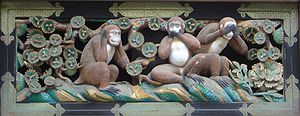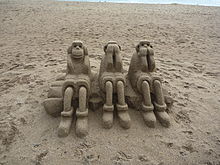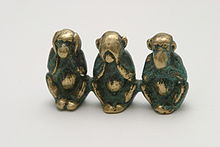- Three wise monkeys
-
This article is about the pictorial maxim. For the Turkish film inspired by the maxim, see Three Monkeys.
The Three Wise Monkeys (Japanese: 三猿, san'en or sanzaru, or 三匹の猿, sanbiki no saru, literally "three monkeys"), sometimes called the Three Mystic Apes,[1] are a pictorial maxim. Together they embody the proverbial principle to "see no evil, hear no evil, speak no evil". The three monkeys are Mizaru, covering his eyes, who sees no evil; Kikazaru, covering his ears, who hears no evil; and Iwazaru, covering his mouth, who speaks no evil. Sometimes there is a fourth monkey depicted with the three others; the last one, Shizaru, symbolizes the principle of "do no evil". He may be shown crossing his arms.
There are various meanings ascribed to the monkeys and the proverb including associations with being of good mind, speech and action. In the Western world the phrase is often used to refer to those who deal with impropriety by looking the other way, refusing to acknowledge it, or feigning ignorance.
In English, the monkeys' names are often given as Mizaru,[2] Mikazaru,[3] and Mazaru,[4] but the last two names were corrupted from the Japanese originals.[5][6]
Contents
Origin
 Kōshin scroll with the three monkeys
Kōshin scroll with the three monkeys
The source that popularized this pictorial maxim is a 17th century carving over a door of the famous Tōshō-gū shrine in Nikkō, Japan. The carvings at Toshogu Shrine were carved by Hidari Jingoro, and believed to have incorporated Confucius’s Code of Conduct, using the monkey as a way to depict man’s life cycle. There are a total of 8 panels, and the iconic Three Wise Monkeys picture comes from panel 2. The philosophy, however, probably originally came to Japan with a Tendai-Buddhist legend, from China in the 8th century (Nara Period). It has been suggested that the figures represent the three dogmas of the so-called middle school of the sect.
In Chinese, a similar phrase exists in the Analects of Confucius from 2nd to 4th century B.C.: "Look not at what is contrary to propriety; listen not to what is contrary to propriety; speak not what is contrary to propriety; make no movement which is contrary to propriety" (非禮勿視, 非禮勿聽,非禮勿言, 非禮勿動).[7] It may be that this phrase was shortened and simplified after it was brought into Japan.
It is through the Kōshin rite of folk religion that the most significant examples are presented. The Kōshin belief or practice is a Japanese folk religion with Chinese Taoism origins and ancient Shinto influence. It was founded by Tendai Buddhist monks in the late 10th century. A considerable number of stone monuments can be found all over the eastern part of Japan around Tokyo. During the later part of the Muromachi period, it was customary to display stone pillars depicting the three monkeys during the observance of Kōshin.
Though the teaching had nothing to do with monkeys, the concept of the three monkeys originated from a simple play on words. The saying in Japanese is "mizaru, kikazaru, iwazaru" (見ざる, 聞かざる, 言わざる, literally "don't see, don't hear, don't speak". However, -zaru, an archaic negative verb conjugation, is pronounced the same as zaru, the vocalized form of saru (猿), "monkey", so the saying can also be interpreted as the names of three monkeys.
It is also possible that the three monkeys came from a more central root than a simple play on words. The shrine at Nikko is a Shinto shrine, and the monkey is an extremely important being in the Shinto religion.[citation needed] The monkey is believed to be the messenger of the Hie Shinto shrines, which also have connections with Tendai Buddhism. There are even important festivals that are celebrated during the year of the monkey (occurring every twelve years) and a special festival is celebrated every sixteenth year of the Kōshin.
"The Three Mystic Apes" (Sambiki Saru) were described[where?] as "the attendants of Saruta Hito no Mikoto or Kōshin, the God of the Roads". The Kōshin festival was held on the 60th day of the calendar. It has been suggested that during the Kōshin festival, according to old beliefs, one’s bad deeds might be reported to heaven "unless avoidance actions were taken…." It has been theorized that the three Mystic Apes, Not Seeing, Hearing, or Speaking, may have been the "things that one has done wrong in the last 59 days."
According to other accounts, the monkeys caused the Sanshi and Ten-Tei not to see, say or hear the bad deeds of a person. The Sanshi (三尸) are three worms living in everyone's body. The Sanshi keep track of the good deeds and particularly the bad deeds of the person they inhabit. Every 60 days, on the night called Kōshin-Machi (庚申待), if the person sleeps, the Sanshi will leave the body and go to Ten-Tei (天帝), the Heavenly God, to report about the deeds of that person. Ten-Tei will then decide to punish bad people, making them ill, shortening their time alive, and in extreme cases putting an end to their lives. Those believers of Kōshin who have reason to fear will try to stay awake during Kōshin nights. This is the only way to prevent the Sanshi from leaving their body and reporting to Ten-Tei.
A uniquely exquisite representation of the 'no see, no hear, no say, no do' is the 4 golden figurines that can be found in Istvan Zelnik Southeast Asian Cultures Goldmuseum. These are four golden statues from the 6th to 8th century. The figures look like tribal human people with not very precise body carvings and besides strong phallical symbols.[8] It shows that this philosopy comes from very ancient routes.
Meaning of the proverb
Just as there is disagreement about the origin of the phrase, there are differing explanations of the meaning of "see no evil, hear no evil, speak no evil."
- In Japan the proverb is simply regarded as a Japanese Golden Rule.
- Some simply take the proverb as a reminder not to be snoopy, nosy and gossipy.
- Early associations of the three monkeys with the fearsome six-armed deity Vajrakilaya link the proverb to the teaching of Buddhism that if we do not hear, see or talk evil, we ourselves shall be spared all evil (refer Three Vajra). This may be considered similar to the English proverb "Speak of the Devil – and the devil appears."
- Others believe the message is that a person who is not exposed to evil (through sight or sound) will not reflect that evil in their own speech and actions.
- Today "See no evil, hear no evil, speak no evil" is commonly used to describe someone who doesn't want to be involved in a situation, or someone willfully turning a blind eye to the immorality of an act in which they are involved. The Italian version, "Non vedo, non sento, non parlo" (I see nothing, I hear nothing, I say nothing), expresses the Omertà, a code of silence enforced by criminal organizations like the Mafia, 'Ndrangheta, and Camorra.
- In many interpretations it can be seen as a way to avoid spreading evil. Do not listen to evil things so they do not influence you. Do not read things that are evil or look upon evil things so they do not influence you, and lastly do not repeat verbally evil things so they cannot be spread about.
Cultural influences
The Three Wise Monkeys, and the associated proverb, are known throughout Asia and in the Western world. They have been a motif in pictures, such as the ukiyo-e (Japanese woodblock printings) by Keisai Eisen.
Mahatma Gandhi's one notable exception to his lifestyle of non-possession was a small statue of the three monkeys. Today, a larger representation of the three monkeys is prominently displayed at the Sabarmati Ashram in Ahmedabad, Gujarat, where Gandhi lived from 1915–1930 and from where he departed on his famous salt march.
The maxim inspired an award-winning 2008 Turkish film by director Nuri Bilge Ceylan called Three Monkeys (Üç Maymun).
Unicode characters
Unicode provides emoticon representations of the monkeys as follows:[9]
- Mizaru: U+1F648
Wikimedia Foundation. 2010.



